Class 8 Science: Sample Question Paper - 9 | Science Class 8 PDF Download
Class - VIII
Science Theory
TIME: 3 Hrs.
M.M: 80
General Instructions:
1. Attempt all the questions and follow the instructions given in each question.
2. Q.No. 1 is the MCQs type; choose the correct option.
3. Q.No. 2 are Very Short Answer Type Questions, carry one mark each.
4. Q.No. 3 to Q.No. 9 are Short Answer Type Questions-I, carry 2 marks each.
5. Q.No. 10 to Q.No 19 are also Short Answer Type Questions-II, carry 3 marks each.
6. Q.No. 20 to Q.No 23 are Long Answer Type Questions, carry 5 marks each.
Q.1. Choose the correct options :
(i) Which is not a Kharif crop?
(a) Paddy
(b) Gram
(c) Maize
(d) Soya bean
Ans: b
Kharif crops are typically sown at the beginning of the monsoon season (June) and harvested at the end of the monsoon season (October) in India. These crops are generally dependent on the monsoon rains for irrigation.
(ii) Which is not classified as a major group of micro-organisms?
(a) Bacteria
(b) Fungi
(c) Protozoa
(d) Plants
Ans: d
Microorganisms are typically classified into several major groups, which include bacteria, fungi, protozoa, algae, and viruses. Plants, on the other hand, are a separate kingdom of multicellular, photosynthetic organisms and are not considered microorganisms.
(iii) Pick out the synthetic fibre from the following?
(a) Cotton
(b) Nylon
(c) Jute
(d) Wool
Ans: b
Synthetic fibers are man-made fibers produced from chemical substances, usually derived from petrochemicals. Nylon is a well-known synthetic fiber, created through a chemical process. In contrast, cotton, jute, and wool are natural fibers obtained from plants and animals.
(iv) Metals can be cut with a knife :
(a) Sodium and Iron
(b) Potassium and Copper
(c) Copper and Iron
(d) Sodium and Potassium
Ans: d
Sodium and potassium are alkali metals, which are characterized by their softness and can be easily cut with a knife. In contrast, metals like iron and copper are much harder and cannot be cut with a knife.
(v) A black, tough and porous substance is:
(a) Coal tar
(b) Coal gas
(c) Coke
(d) Diesel
Ans: c
Coke is a black, tough, and porous substance. It is derived from coal through a process called destructive distillation. Coke is primarily used as a fuel and a reducing agent in smelting iron ore in a blast furnace. Coal tar and coal gas are by-products of the coke production process, while diesel is a liquid fuel derived from crude oil.
(vi) Which one of the following has the highest calorific value?
(a) Kerosene
(b) Biogas
(c) LPG
(d) Petrol
Ans: c
Calorific value refers to the amount of energy produced by the complete combustion of a material or fuel. Among the options given, LPG (Liquefied Petroleum Gas) has the highest calorific value. It is a highly efficient fuel commonly used for cooking and heating. Kerosene, biogas, and petrol also have high calorific values, but not as high as LPG.
(vii) The Red Data Book keeps a record of all the
(i) endemic species
(ii) endangered plants
(iii) extinct species
(iv) endangered animals
(a) (i) & (ii)
(b) (ii) & (iii)
(c) (iii) & (iv)
(d) (i) & (iv)
Ans: c
The Red Data Book, also known as the Red List, is a record of species that are facing the risk of extinction. It includes information on endangered and critically endangered species, both plants and animals. It does not typically include endemic species (those found only in a specific geographic area) or extinct species (those no longer in existence).
(viii) The jelly-like fluid substance present in cells is called
(a) Protoplasm
(b) Chloroplast
(c) Chromosome
(d) Cytoplasm
Ans: d
Cytoplasm is a jelly-like fluid substance present in cells. It surrounds the organelles within the cell and is where many of the cell's biochemical reactions take place.
(ix) In humans, the development of fertilised egg takes place in
(a) ovary
(b) testes
(c) oviduct
(d) uterus
Ans: c
In humans, the development of the fertilized egg, or zygote, takes place in the oviduct, also known as the fallopian tube. After fertilization occurs in the oviduct, the zygote undergoes several cell divisions as it moves toward the uterus, where it implants and further develops into an embryo.
(x) Protruding part of the throat in a boy is called
(a) Voicebox
(b) Larynx
(c) Adam’s Apple
(d) All of these
Ans: c
The Adam's apple is the protruding part of the throat that is more prominent in males. It is actually the thyroid cartilage of the larynx, which tends to be larger in males and becomes more prominent during puberty due to the growth of the larynx (voice box) and the associated increase in testosterone levels.
Q.2. (i) Can coal, petroleum and natural gas be prepared in the laboratory from dead organisms?
Ans: No, their formation is a prolonged process, and conditions for their formation cannot be created in the laboratory.
(ii) What do you mean by combustion?
Ans: A chemical process in which a substance burns in oxygen to release heat is called combustion.
(iii) Why is it important to conserve forests?
Ans: Forest conservation maintains the balance in nature; it acts as carbon activators absorbing CO2 and keeps global warming away.
(iv) Name the cell in the human body that receives and transfers messages.
Ans: Nerve cell.
(v) Name any two non-contact forces.
Ans: Non-contact forces :
(a) Gravitational force
(b) Magnetic force.
(vi) How does the amplitude affect the loudness of the voice?
Ans: Higher is the amplitude, louder is the voice.
Q.3. Write any three positive characteristics of plastic.
Ans: Plastic is solid, light and durable. It can be moulded into different shapes and sizes. It is used for various purposes. Plastics are generally cheaper than metals. They are widely used in industry and for household articles.
Q.4. What are thermosetting plastics? Write two examples of their characteristics.
Ans: There are some plastics which, when moulded once, cannot be softened by heating.
These are called thermosetting plastics. e.g., Bakelite and melamine.
Bakelite: It is a poor conductor of heat and light.
Melamine: It is fire resistant.
Q.5. Draw a well-labelled diagram of human sperm.
Ans: Human Sperm:
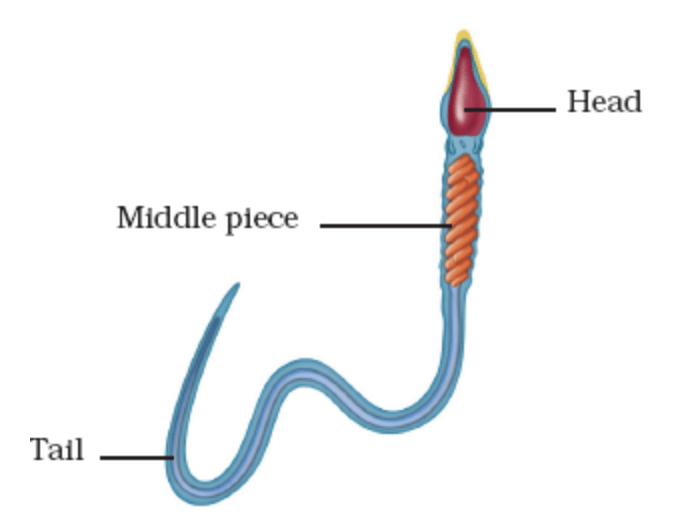
Q.6. Explain how CO2 can control fibres?
Ans: Actually, CO2 cuts off the supply of air to the combustible substance, or it brings down the temperature of the combustible substance below its ignition temperature by forming a layer on that substance, due to which it stops the fire.
Q.7. Draw binary fission in Amoeba.
Ans:

Q.8. What is a gene? What is its function?
Ans: Gene is a unit of inheritance in living organisms. It controls the transfer of hereditary characteristics from parents to offsprings.
Q.9. Answer the following :
(i) Which micro-organism is used in making curd from milk?
(ii) Which micro-organism is used for making bread?
Ans: (i) Lactobacillus is used in making curd from milk.
(ii) Yeast is used for making bread.
Q.10. Why is it easy to drag a mat when nobody is sitting on it but difficult when somebody is sitting on it?
Ans: We know that friction is caused by the interlocking of the two surfaces' irregularities. The force of friction will increase if the two surfaces are pressed harder. So it is easy to drag a mat when nobody is sitting on it but difficult when someone is sitting on it.
Q.11. Compare the sound of drum and whistle.
Ans: The frequency determines the shrillness or pitch of a sound. A drum vibrates with low frequency. Therefore, it produces a low pitched sound. Whistle has a high frequency and produces a sound of higher pitch.
Q.12. Explain why :
A pencil will write on paper but not on the glass.
Ans: Due to friction, a pencil writes on paper, but as there is smoothness on the glass's surface, a pencil cannot write on glass.
Q.13. What are the effects of force?
Ans: A force changes or try to change the
(i) speed of a moving body.
(ii) the direction of motion of a body.
(iii) the shape of a body.
Q.14. Observe the following diagram :
Answer the following questions :
(i) Does it represent a plant cell or an animal cell?
(ii) Does it represent a prokaryotic cell or a eukaryotic cell?
Ans: (i) The above diagram represents an animal cell because the cell membrane binds the cell, and the cell wall is absent.
(ii) The above diagram represents a eukaryotic cell as it has a well-organized nucleus and other cell organelles in it.
Q.15. Draw a sketch of animal cell and plant cell showing differences between them.
Ans:
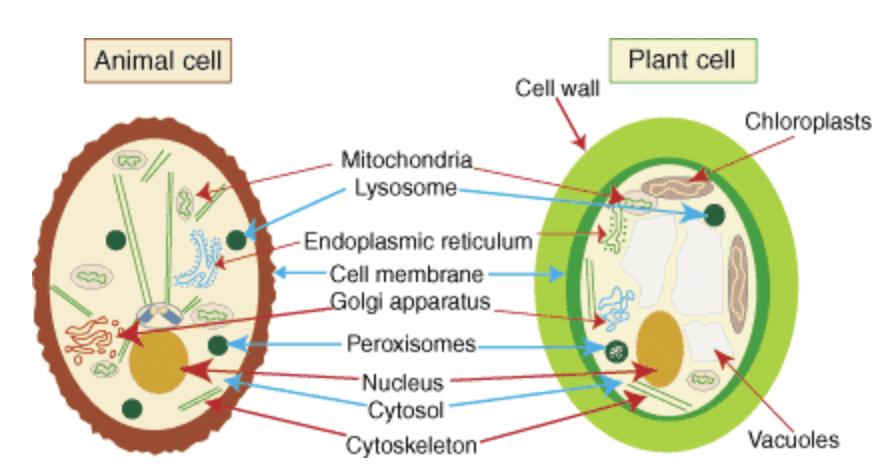
Q.16. Give a few examples to show that plastics are non-corrosive in nature.
Ans: Corrosion of a substance is the reaction with water or moisture of the air and getting damaged. Following are a few examples :
(i) We use buckets and mugs made up of plastics in our bathrooms regularly, but they remain as it is for a long time period.
(ii) Plastics do not decompose in the atmosphere for a long period.
(iii) Many health care products, such as packaging of tablets, threads used for stitching wounds, remain in their original look for a long time period.
Q.17. The eyes of the nocturnal birds have large cornea and a large pupil. How does this structure help them?
Ans: The size of the eyes of nocturnal birds is large. Large eyes with a wider pupil, larger lens and increased retinal surface can collect more ambient light, which helps them to see the objects even at night easily.
Q.18. Draw a sketch of a prokaryotic cell.
Ans:

A generalised prokaryotic cell of a bacterium
Q.19. Draw a well-labelled diagram of the ultrastructure of the Nucleus.
Ans: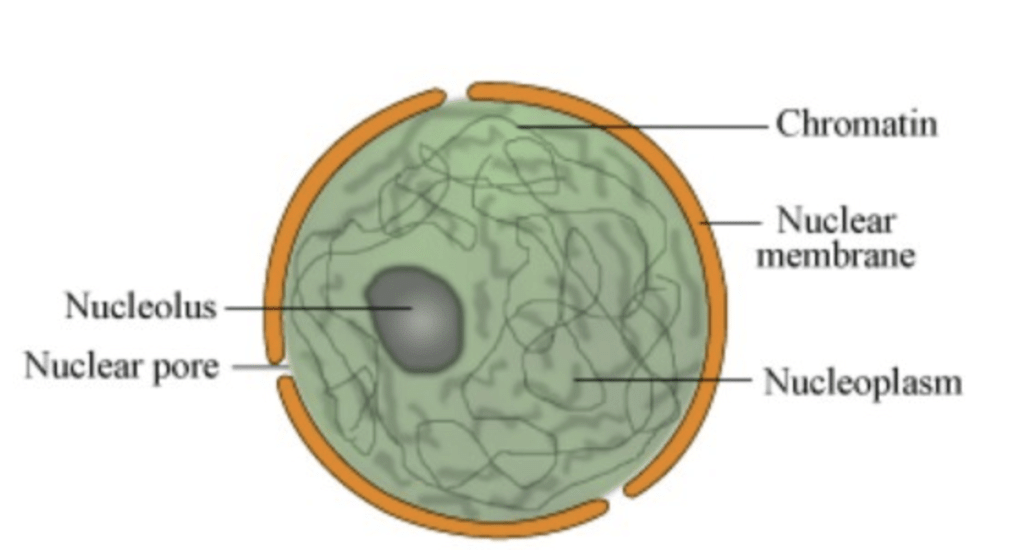
Q.20. (a) Which part of the cell contains organelles?
(b) State three differences between plant cell and animal cell.
(c) Where are chromosomes found in the cell?
Ans: (a) Cytoplasm contains all the organelles of the cell. Organelles are the small structures present inside the cell with their specific structure and specialised functions.
(b)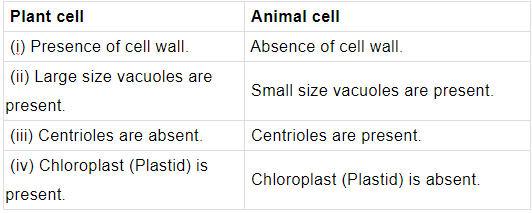
(c) Chromosomes are the thread-like structures found inside the nucleus, present in the cell.
Q.21. What is electroplating? What are its advantages?
Ans: 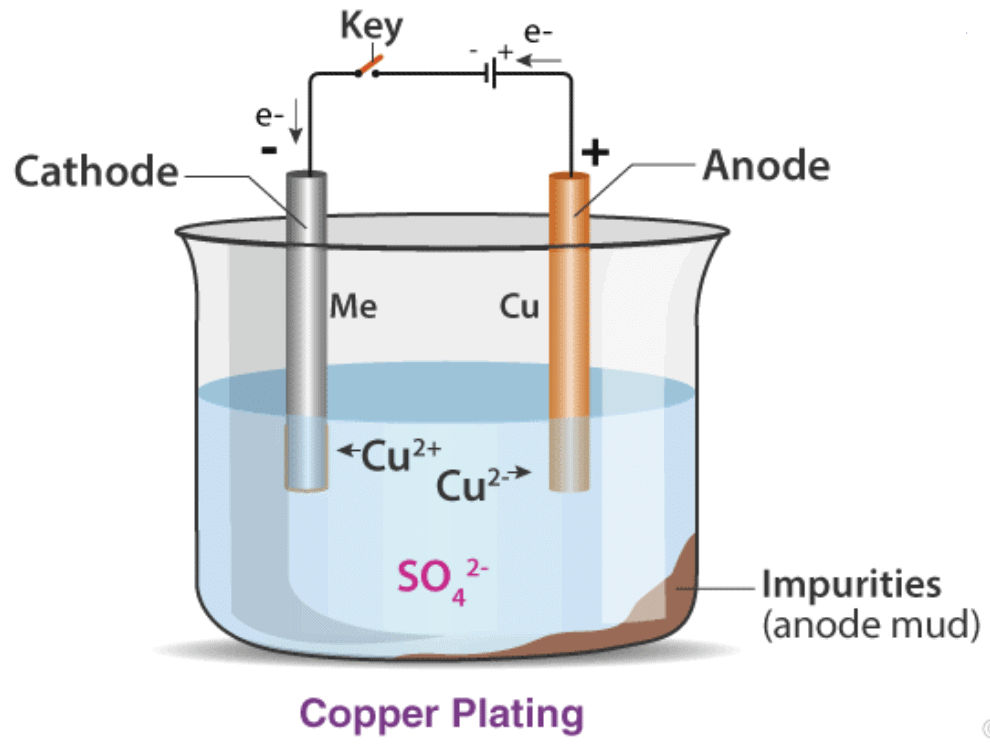
Electroplating is the process of depositing a layer of any desired metal on another metal using electricity.
Advantages of Electroplating :
(i) It is used to coat the desired metal on another metal.
(ii) It protects the metals from corrosion.
(iii) It also prevents the metallic surface from rusting.
(iv) Some cheap and dull metals are coated with costly and shining metals for ornamental use.
(v) It can make more reactive metals like iron less reactive.
(vi) Coating of chromium on metals gives lustre to objects.
Q.22. In the circuit, as given in Fig., Boojho observed that copper is deposited on the electrode connected to the negative terminal of the battery. Paheli tried to repeat the same experiment, but she could find only one copper plate. Therefore, she took a carbon rod as the negative electrode. Will copper be still deposited on the carbon rod? Explain your answer.
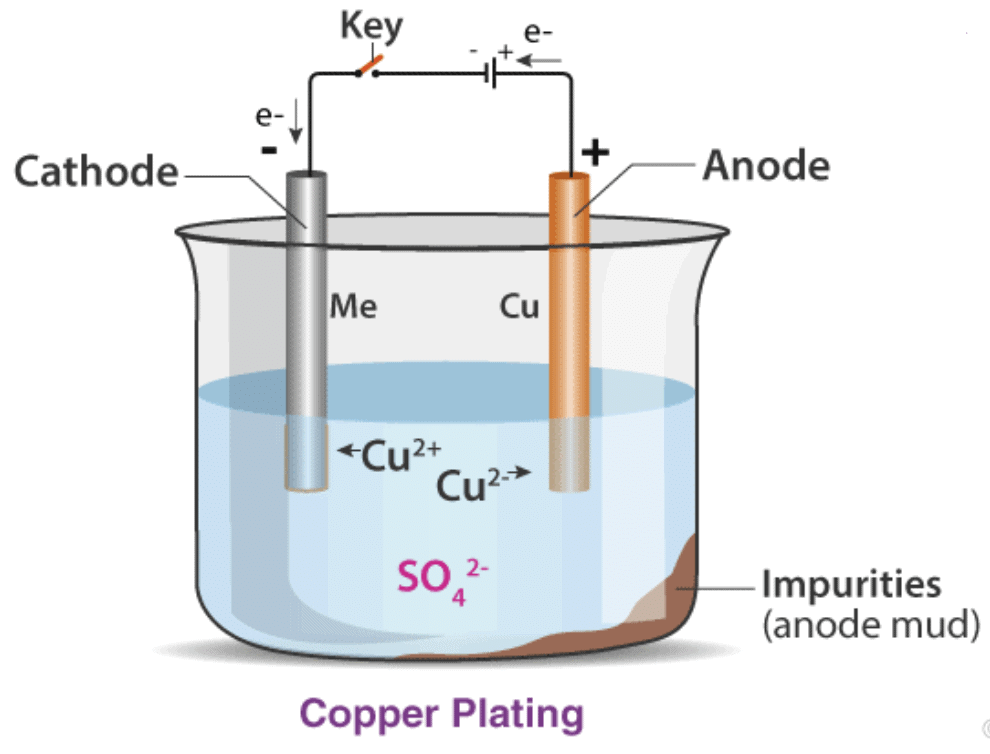
Ans: Copper will not be deposited on the carbon rod because it is a poor conductor of electricity. For electroplating, the circuit must be completed, and that can be completed only by using the conducting material. Instead of a carbon rod, it should be any metal, then only it can be electroplated.
Q.23. Explain how fertilizers are different from manures?
Ans: Fertilizers differ from manures in the following ways :
(i) Manures are organic substances, while fertilizers are chemical substances.
(ii) Manures are prepared in fields, while fertilizers are prepared in factories.
(iii) Manures contain all the nutrients, while fertilizers are rich in certain nutrients.
(iv) Manures provide humus, while fertilizers do not provide it.
|
90 videos|296 docs|44 tests
|
FAQs on Class 8 Science: Sample Question Paper - 9 - Science Class 8
| 1. What is the function of the nervous system in the human body? |  |
| 2. How does the nervous system help in responding to stimuli? |  |
| 3. What are the two main parts of the nervous system? |  |
| 4. How do neurons transmit signals in the nervous system? |  |
| 5. What are some common disorders of the nervous system? |  |

















